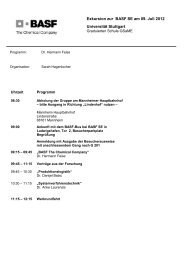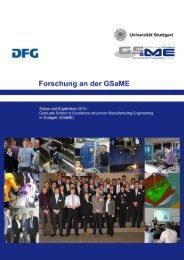Forschung an der GSaME - Status und Ergebnisse 2012
Forschung an der GSaME - Status und Ergebnisse 2012
Forschung an der GSaME - Status und Ergebnisse 2012
- Keine Tags gefunden...
Sie wollen auch ein ePaper? Erhöhen Sie die Reichweite Ihrer Titel.
YUMPU macht aus Druck-PDFs automatisch weboptimierte ePaper, die Google liebt.
produktionsspezifischen operativen <strong>und</strong> prozessbezogenen Daten, z.B. aus MES <strong>und</strong>Enterprise Resource Pl<strong>an</strong>ning (ERP) Systemen, einzunehmen. Darüber hinaus werdentypischerweise keine Technologien zur Mustererkennung, wie z.B. Data Mining, eingesetzt,um optimierungsrelev<strong>an</strong>te Datenkonstellationen jenseits einzelner Ressourcen o<strong>der</strong>Fertigungsschritte zu identifizieren.Ziel des <strong>Forschung</strong>sprojekts ist die Entwicklung einer integrierten Business IntelligencePlattform für die datengetriebene Optimierung von Fertigungsprozessen. Hierbei geht es umdie Entwicklung eines g<strong>an</strong>zheitlichen prozessbezogenen Data Warehouse, das operative <strong>und</strong>prozessbezogene Fertigungsdaten integriert <strong>und</strong> für unterschiedliche Analysen zur Verfügungstellt. Darauf aufbauend erfolgt die Definition von Data-Mining-basierten Anwendungsfällen,z.B. für Ursache-Analysen von Produktionsfehlern o<strong>der</strong> Echtzeitprognosen von KeyPerform<strong>an</strong>ce Indicators über den gesamten Fertigungsprozess. Zudem werden Ansätze zurpräskriptiven Optimierung untersucht, mittels <strong>der</strong>er konkrete Vorschläge zurProzessverbesserung generiert werden. Darüber hinaus sollen Analyseergebnisse imRahmen eines datenb<strong>an</strong>kgestützten Wissensm<strong>an</strong>agement<strong>an</strong>satzes gespeichert <strong>und</strong>gemeinsam genutzt werden. Zielgruppen <strong>und</strong> Nutzer <strong>der</strong> <strong>an</strong>alytischen Dienste <strong>der</strong> Plattformsind im Sinne eines umfassenden Perform<strong>an</strong>ce M<strong>an</strong>agement Ged<strong>an</strong>kens nicht nurFertigungsleiter <strong>und</strong> Produktionsm<strong>an</strong>ager, son<strong>der</strong>n auch Werker in <strong>der</strong> Fabrik.ThemaE4: Neue Kommunikationsarchitektur für EchtzeitfabrikenDoktor<strong>an</strong>d:M. Sc. Bilal HameedThesis Committee: Prof. Dr. rer. nat. Kurt Rothermel (IPVS)Prof. Dr.-Ing. Engelbert WestkämperProjektbeginn: 01.08.2008ZusammenfassungNovel Communication Architecture for the RealTime FactoryToday, m<strong>an</strong>y m<strong>an</strong>ufacturing comp<strong>an</strong>ies pursue vari<strong>an</strong>t production in which each product iscustomized according to individual user dem<strong>an</strong>ds. In vari<strong>an</strong>t production it is essential to ensurethe correctness of the m<strong>an</strong>ufacturing process or the produced products will not match thecustomers’ requirements. To detect errors during the process as soon as possible, Project E5designs concepts <strong>an</strong>d algorithms for the real-time monitoring of such production processes.Due to its technical adv<strong>an</strong>tages such as contact-less non-line-of-sight identification <strong>an</strong>d bulkreadingcapability, we focus on RFID technology for the purpose of real-time monitoring ofproduction processes. A major challenge is to deal with the inevitable unreliability of RFIDsystems causing, for inst<strong>an</strong>ce, false or missed readings. In or<strong>der</strong> to resolve these reliabilityissues, we proposed <strong>an</strong> RFID-based framework in our previous work that uses multiple RFIDrea<strong>der</strong>s deployed along production lines to monitor product parts <strong>an</strong>d detect product partsequences. The basic idea is to increase reliability by exploiting red<strong>und</strong><strong>an</strong>t readings frommultiple (unreliable) rea<strong>der</strong>s. Using multiple readings, we designed probabilistic part <strong>an</strong>dsequence detection algorithms.72











